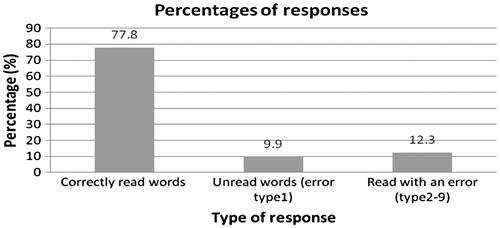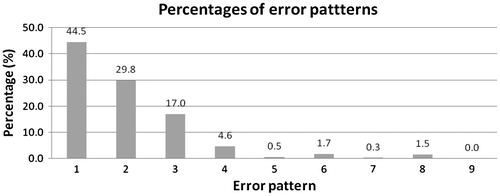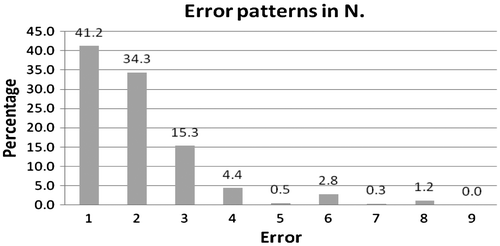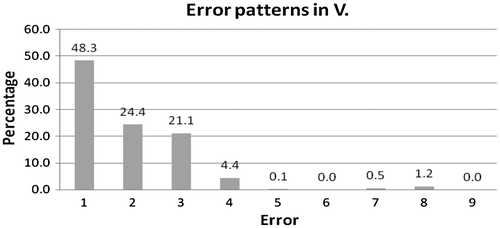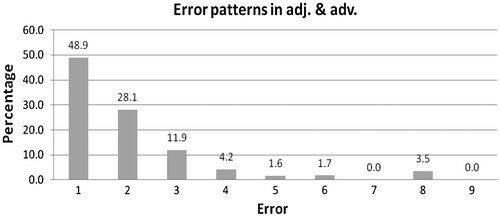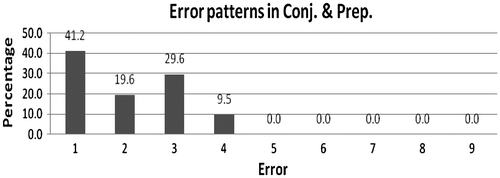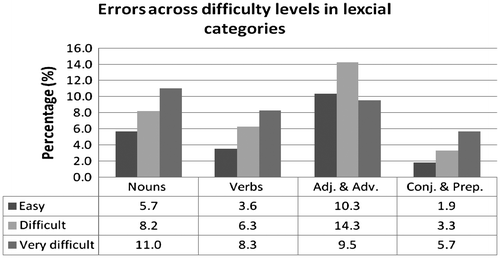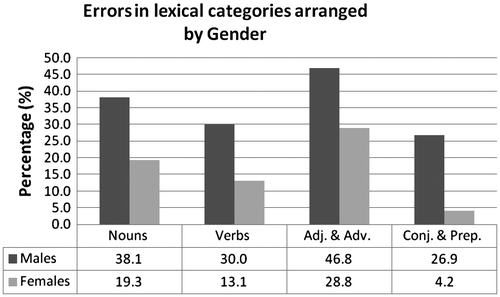Abstract
There is a contemporary emphasis on researching the effects of phonological awareness on reading skills though morphological awareness correlates more highly with reading. The purpose of the study was to investigate the patterns of reading errors from a morphological perspective (level of morphological complexity) and lexical category. One hundred and eighty-three Emirati regular education first graders, (54 male and 129 female) were presented with 96 randomly chosen words from the curriculum. Those were classified into lexical categories representing: nouns (43 words, 44.79%), verbs (32 words, 33.33%), adjectives and adverbs (11 words, 11.46%), and function words (i.e. preposition and conjunctions) (10 words, 10.42%). Words were classified into three levels of linguistic difficulty (easy, difficult, and very difficult) according to their morphological complexity. One male teacher participated in data collection to ensure procedural consistency. Nine reading error patterns were identified. Significant differences between male and female students in reading the target words were found. Results also indicated that reading difficulties may stem from a distinct, though interrelated, threefold paradigm: difficulty level of the read words (i.e. morphological complexity), lexical category (nouns, verbs, adjective and adverbs, prepositions and conjunctions), and pattern of reading error (e.g. omission of a letter or a syllable and reading the geminated letter as ingeminated). This study mapped the threefold paradigm (difficulty level, lexical category, and patterns of reading error) in individual students may be helpful in predicting reading errors and delineating the focus and strategies of instructional programs.
Public Interest Statement
A variety of resources have emphasized the significance of phonological awareness (awareness of oral language- related to spoken language) in the acquisition of reading skills. Morphological awareness (awareness of word structure- related to written language) correlates with reading acquisition, and the understanding of its association with the patterns of reading errors can contribute in developing teaching methods for reading. This study aimed to describe and quantify the types of reading errors, and to determine if there were association between types of reading errors and gender. A nascent finding was the presence of interplay between the strategies used in teaching, the age and gender of students, and the difficulty level of the words targeted for reading. This study spotlighted the importance of the characteristics and the content of the curricula, and its influence the learning process. Reading instructional strategies for teaching first graders should consider that learners need to have phonological awareness as well print awareness and oral language, which are considered three important areas associated with emergent reading abilities.
1. Introduction
Reading is not an easy task for children (Swank & Catts, Citation1994). There have been multiple approaches posited in the literature to treat or/and develop phonological and reading skills such as the phonological approaches, auditory approaches, articulation approaches (Murphy, Pagan-Neves, Wertzner, & Schochat, Citation2015). The earliest traditional phonological approach was the articulation approach (Van Riper, Citation1939), that has been gradually combined with other phonological approaches such as the phonological remediation approach and the core vocabulary approach (Crosbie, Pine, Holm, & Dodd, Citation2006; Murphy et al., Citation2015).
Researchers related reading to various mental processes such as phonological and morphological awareness, among others. In order to decode words, children have to learn the grapheme–phoneme relationship via the process of phonological awareness (Morton, Citation2011). Difficulties in reading may be due to difficulty with mental processing of phonological information. (Adams, Citation1990; Hoskyn & Swanson, Citation2000; Stanovich, Citation1988; Stanovich & Siegel, Citation1994; Stone & Brady, Citation1995). Thus, phonological awareness (PA) was broadly studied to detect its relationship to reading difficulties Siegel (Citation2008).
PA, according to Schuele and Boudreau (Citation2008), is an umbrella of skills that enables individuals to manipulate phonemes in a given language. Researchers outlined the correlation between phonological awareness and reading abilities at the first grade (Catts, Citation1993; Catts, Fey, Zhang, & Tomblin, Citation2001; Swank & Catts, Citation1994). Similarly, Pratt and Brady (Citation1988) found the same pattern of relationship between phonological awareness and reading abilities in older children (third grade), and adults. Moreover, research showed improved reading abilities following phonological awareness training (Torgesen et al., Citation1999; Wise, Ring, & Olson, Citation1999). In addition to PA, the relationship between reading and other phonological processes was studied. According to Anthony, Williams, McDonald, and Francis (Citation2007), three interrelated phonological processing abilities (PPA) are important for reading and writing: PA, that enables individuals to detect and manipulate sounds in their language; phonological memory (PM) which refers to “coding information in sound-based representation system for temporary storage” (Anthony et al., Citation2007, p. 114), and efficiency of phonological access to lexical storage that enables individuals to retrieve phonological codes from memory. Understanding how these three processes relate to each other would have implications for the development of assessment batteries, better identification of children at risk of reading difficulties, and better intervention with these children (Anthony et al., Citation2007). Similar to phonological awareness, phonological memory (Rapala & Brady, Citation1990; Rohl & Pratt, Citation1995; Snowling, Goulandris, Bowlby, & Howell, Citation1986; Stone & Brady, Citation1995), and phonological access to lexical storage (Felton & Brown, Citation1990; Griffiths, Citation1991; Wagner et al., Citation1997; Wolf & Obregón, Citation1992) could predict reading problems (Anthony et al., Citation2007).
Thus, PA is an important skill to assess in order to predict and intervene against reading disabilities (Pokorni, Worthington, & Jamison, Citation2004; Torgesen, Wagner, Rashotte, Herron, & Lindamood, Citation2010; Torgesen et al., Citation1999). However, there might be other factors affecting children’s reading other than PA problems. Although the study of Bus, van IJzendoorn, and Marinos (Citation1999), a meta-analysis of the effects of PA on reading abilities, showed the importance of PA, it also showed that PA is not sufficient for developing early reading abilities. They found that programs which combined both phonological and letter training were more effective than programs where phonological training was only used. On the other hand, the National Early Literacy Panel [NELP], Citation2007 meta-analysis of peer-reviewed longitudinal studies of the power of preschool and kindergarten emergent literacy skills found that all of the emergent literacy skills (e.g. PPA, letter knowledge, and oral language) were reliable predictors of reading abilities. Similarly, Bowers and Kirby (Citation2010) found that vocabulary knowledge plays a fundamental role in literacy development and success at school. According to Biemiller and Boote (Citation2006), brief explanations of one or two sentences can be sufficient to establish effective referents for new words and is the beginning of acquiring that word. Besides, metalinguistic processing has garnered growing interest in the literature as an important word-learning skill (Baumann et al., Citation2002; Henry, Citation1989, Citation2003; Nagy, Citation2005; National Reading Panel, [NRP], Citation2000; Scott, Citation2005; Templeton, Citation1989, Citation2004).
Though there is a contemporary emphasis on researching the effects of PA on reading skills, another related important process has an importance for reading ability is morphological awareness. Siegel (Citation2008) stated that morphological awareness correlates more highly with spelling and reading than phonological and syntactic awareness although phonological awareness had the major interest in research. Reading involves grapheme–phoneme conversion, which implicates the significant role of phonological awareness in reading. As such and as an interrelated skill, morphological decomposition is needed to read more complex words (Verhoeven & Perfetti, Citation2011). Morphological knowledge has the potential to affect literacy skills in at least three ways: through word recognition, comprehension, and motivation (Bowers, Kirby, & Deacon, Citation2010). According to the authors, word recognition is supported by phonological awareness, rapid automatized naming, orthographic processing, and vocabulary knowledge (Bowers et al., Citation2010; Carlisle, Citation2003; Carlisle & Stone, Citation2005; Deacon & Kirby, Citation2004). Additionally, morphological knowledge was found to be a good predictor of sublexical tasks (e.g. pseudo-word reading) (e.g. Deacon & Kirby, Citation2004; Fowler & Liberman, Citation1995; Roman, Kirby, Parrila, Wade-Woolley, & Deacon, Citation2009), and lexical tasks (word reading accuracy), (e.g. Bowers et al., Citation2010; Carlisle, Citation1995; Carlisle & Katz, Citation2006; Fowler & Liberman, Citation1995; Leong, Citation1989; Roman et al., Citation2009; Singson, Mahony, & Mann, Citation2000).
Mahfoudhi, Elbeheri, Al-Rashidi, and Everatt (Citation2010) found conflicting results with what have been posited in the literature as morphological measures predicted comprehension in mainstream children better than phonological skills, though they were not sensitive to predict comprehension in children with learning disabilities. Some studies showed the importance of working on morphological knowledge and the effect of explicit morphology instruction on children with learning difficulties (Deacon, Parrila, & Kirby, Citation2008; Elbro & Arnbak, Citation1996). Ghaemi (Citation2009) found that morphological training has improved students’ reading. However, although it resulted in some improvement, it was less effective compared to phonological awareness treatment for kids with reading difficulties. The author suggests an interactive relationship between phonological awareness and morphological knowledge in reading ability.
On the other hand, in their designed intervention program for a six-year-old child who had dyslexia, McLeod and Apel (Citation2015) found that the employment of morphological awareness approach resulted in developing the child’s morphological awareness and reading skills. In addition, Law, Wouters, and Ghesquière (Citation2015) studied morphological awareness in university students with dyslexia, and compared the utilization of morphological awareness skills between students with and students without dyslexia (i.e. control group). They found that the reading and language skills in university students who had dyslexia are dependent on the use of morphological awareness as a mean of compensations to phonological awareness. Also, Law et al. (Citation2015) found that the morphological awareness is as equally important for reading skills to students without dyslexia as those with dyslexia. Goodwin and Ahn (Citation2010) in their meta-analysis of the effects of morphological interventions on literacy achievement found that morphological instruction was effective with children with reading and learning disabilities and struggling readers. The authors connected that effect by remediating phonological processing problems. Morphological strategies are important to study because children with dyslexia used morphology as compensation strategies in reading (Sartawi, Citation1999).
Arabic has its distinctive morphological and phonological structure. According to Watson (Citation2002), Arabic language consist of three basic vowels; /a, u, i/ with short and long forms. However, Fareh, Hamdan, Amayreh, and Anani (Citation2000) stated that Arabic includes six vowels (i, e, a, a, o, u). There are 28 consonants in 9 places of articulation. Arabic, as other Semitic languages are marked by laryngeals, pharyngeals, and uvular fricatives (Watson, Citation2002). In her description of Arabic morphology, Watson (Citation2002) specified some features: The noun root consists of two, three, and four consonants; nouns in Arabic has feminine and masculine gender, singular, dual, and plural number; predicative adjectives agree with the noun subject in gender and number; attributive adjectives agree with the attributed noun in gender, number, case, and definiteness; and Arabic has three pronominal forms: independent subject pronouns, bound possessive, and object pronouns which are suffixed to nouns and verbs. On the other hand, verbs in Arabic consist of trilateral or quadrilateral roots. These stems are formed by root morpheme and vowel melody. According to Sforza, Soudi, and Teruko (Citation2000), there are 15 triliteral patterns, 9 of which are commonly used, and 4 quadraliteral patterns which are less common than triliteral patterns.
Thus, it seems that Arabic is heavily influenced by morphological markers. As such, instruction strategies that rely exclusively on PA may not be fully effective in equipping first graders with strategies that would enhance their emerging reading abilities. Skillful readers seem to recognize familiar words visually where they visually process every individual letter of every word as they read (Adams, Citation1990). This is evident when skillful readers detect sometimes the slightest misprint that may appear in a long word or a text. In addition, skillful readers also use context to speed the interpretation of orthographic information only after the word is identified. That is, context does not take the place of orthographic information. Therefore, skillful readers should possess the knowledge of word’s morphological structure and pronunciation. Spelling–sound associations serve seem to function only as a backup system for recognizing visually less familiar words. Research clearly indicates the importance of both the alphabetic script with its morphological components and the phonological processor in the process of reading. Observations of everyday reading behavior of beginning readers clearly reveal this sounding out behavior in both reading and writing attempts. Therefore, activating the morphological awareness skills plays a critical role in the process of learning to read (Deacon et al., Citation2008; Elbro & Arnbak, Citation1996). In fact, understanding and using the alphabetic principle depends equally on knowledge of letters and explicit awareness of the phonemes these letters represent. Adams (Citation1990) has stated that “knowledge of letters and phonological awareness have been found to bear a strong and direct relationship to success and ease of reading acquisition” (Adams, Citation1990, p. 44).
2. Aims and objectives of the study
Reasons that prompted the current investigation is to (1) describe and quantify the types of reading errors and (2) to determine if differences in errors exist by gender.
3. Methods and procedure
The curriculum of Arabic reading adopted in the Emirate of Abu Dhabi, United Arab Emirates has been developed by Abu Dhabi Council for Education (ADEC) as part of its educational reform which has started in 2005. For the purpose of this study, a team consisted of two special education specialists (one is a professor with 25 years’ experience in special education, and one assistant professors with 15 years of experience in special education) and a speech language pathologist (associate professor with 20 years of experience in speech–language pathology) was formulated to review the first grade Arabic reading curriculum in order to establish a baseline concerning the overall frequency of words, and across the lexical categories. In addition, the team was required to establish criteria for morpheme count. After data collection, the team members were also assigned to establish criteria of categorization of severity of errors committed by first graders based on members’ consensus of the effect of the committed error on the intelligibility of the word.
The review revealed the following: word count across the curriculum was detected (484 words). The total lexical categories were also classified representing nouns (N) (45%), verbs (V) (34%), adjectives (Adj.) and adverbs (Adv.) (11%), and function words (preposition and conjunctions) (10%). Words were then classified according to three levels of linguistic difficulty (easy, difficult, and very difficult). All examples cited in this investigation were written in English, phonetic transcription and Arabic script, respectively, for purposes of clarification for diverse readers.
Difficulty levels were assigned by the three specialists unanimously according to one or more than one of the following criteria: “Easy to read” words were considered to be simple when they constituted of one syllable (e.g. shelf /raff/رَفّ), and were vowelized where appropriate. Also, easy words constituted one to two morphemes (e.g. bear /dub/دُبْ). In addition, the orthographic nature of the letters was simple in the sense that the shape of the letter when in isolation was exactly the same when it appeared in those words (e.g. tambour /daff/ دف), and/or were frequently used words in the curriculum (e.g. bread /χ℧bz/خُبز), “Difficult to read” words were at least bi-syllabic (e.g. guard /ћaris/حارس), constituted one to two morphemes (e.g. steady /θa:bet/ ثابت), the orthographic nature of the letters was not simple in the sense that the shape of the letter when in isolation was not the same when it appeared in those words (e.g. creative /mubdiʢa(h)/ مُبدِعَة) (e.g. The basket /ʡassalla/ السلّة), and/or were less frequent words throughout the curriculum (e.g. olives /zajtu:n/زيتون). “Very difficult to read” words were multi-syllabic (e.g. chirp /tuzaqziq/ تُزقْزِقْ), constituted up to three morphemes (e.g. the bicycle /ʡaddara:dʒah/ الدَّراجَة), the orthographic nature of the letters was difficult in the sense that the words constituted letters that have both similar and different shapes than when in isolation (e.g. hose /χartu:m/ خَرطُومْ), and/or were least frequent words throughout the curriculum (e.g. (he) threw it /ʡalqa:ha/ أَلقَاهَا).
Criteria of morpheme count established by the members of the review team were as follows: roots were considered as one morpheme, any derivational or inflectional morpheme was counted as one morpheme (e.g. the definite article), past tense that consisted of three letters was counted as one morpheme, past tense that consisted of four letters was considered to constitute two morphemes, and any verb with a prefix was counted as two morphemes.
After that, the (484) words included in the curriculum were organized in a list and arranged in tables according to the three aforementioned lexical categories and difficulty levels. Then, a sample of 20% (96 words) of the first-grade words was randomly chosen. The reason for that is to present a number of words that a first grader can manage to read within a conventional period of time of a class session which constitutes (45–50 min), within which a student is accustomed to preserve his concentration and attention. Words were randomly selected from multiple reading passages to represent the variation of word category, difficulty levels, and to match the various levels of students’ reading abilities. The resulting words were again, assigned to each of the four lexical categories and the three difficulty levels. The percentage of the randomly chosen words in each lexical category was correspondent with the total percentage of counted words across the curriculum. Therefore, (43) nouns (N) were chosen, (14 easy, 14 difficult, and 15 very difficult), which constituted (44.8%) of the randomly chosen words. (32) Verbs (V) were chosen and which constituted (33.3%) of thee chosen words, (11 easy, 11 difficult, and 10 very difficult). (11) Adjectives and adverbs (Adj. & Adv.) constituted (11.5%), (4 easy, 4 difficult, and 3 very difficult). At last, (10) function words (preposition and conjunctions) constituted (10.4%) of the chosen words, (3 easy, 3 difficult, and 4 very difficult).
The selected words were presented to 183 Emirati regular education first graders, (54 males and 129 females). Participants were 183 Emirati regular education first graders, (54 male and 129 female), who have enrolled in the first grade for one semester (the first semester). Data collection was conducted during the whole second semester (i.e. around four months), while students were receiving their regular reading instruction. Each student was presented with a table consisting of the words to individually read, while the teacher orthographically recorded their responses.
For purposes of methodological consistency, one classroom teacher was trained how to score the answers on the response form, where he was instructed to document each student’s response in writing (right or wrong response) and to write the wrong response as per the student’s pronunciation. The teacher, then, had to write the type of error each student made and to grade it. Errors were assigned the pre-set grade point according to the type of committed error. Grade points were assigned according to the severity of the reading error (i.e. the more severe the committed error, the less grade the student scored). Teachers are accustomed to assigning less grades to more serious errors, thus the grading system conformed to their default practices. This grade system was also intended to guide the researchers in the statistical analysis. The grading process was overviewed by the members of the assigned committee. Collecting the data took the whole second semester (i.e. around four months).
4. Data analysis
Descriptive statistics were generated including the percentages of correct and incorrect responses in each category arranged by reading difficulty. A Mann–Whiteny U test (non-parametric) was also conducted to check for significant differences between the two groups (male versus female students) in terms of their performance as indicated by grades assigned to each unique answer (individual words), as it sheds light on the errors pattern in each word. The data were analyzed using SPSS version 22.0 × 64 for windows (SPSS Inc.).
5. Results and discussion
As in the literature, there was no particular measurements/standards in judging the severity of errors, after consultation with the assigned experts, grade points were assigned to error patterns according to the degree they affect intelligibility of the read word as follows: correctly read word (no grade point was assigned); error 1, inability to read the word, which is the most severe error, (1 point); error 2, omission of a letter or a syllable (2 points); error 3, substitution of a letter or a syllable (3 points); error 4, addition of a letter or a syllable (4 points); error 5, non-discrimination between the /h/ (al-ha’) and the /t/ (at-ta’ al-marbouta) at the end of words (5 points); error 6, non-discrimination between the regular /l/ (al-qamariyya) and the silent /l/ (ash-shamsiyya) (6 points); error 7, not reading the glottal stop /ʡ/ (hamza) (7 points); error 8, reading the geminated letter as ingeminated (8 points); error 9, non-discrimination between hamzat al-wasl and hamzat al-qat’ (9 points).
5.1. Percentages of reading error patterns
Descriptive analysis revealed that the total number of correct reading trials, in both genders, was 13,667 out of 17,568 which constituted a percentage of 77.8% of the overall number of reading trials, while the trials where the student was unable to read the word, that is type1 error, constituted 9.9%. The percentage of trials where words were erroneously read, that is errors 2, 3, 4, 5, 6, 7, and 8, constituted 12.3% of the overall number of reading trials. Figure summarizes the above.
Of the reading errors patterns that constituted around (22.2%) of the overall reading responses, the most common committed errors were error 1, 2, 3, 4, 6, 8, 5, and 7, respectively, as shown in Figure below and Table . Error 9 was not committed by any of the students in any of the reading trials.
Table 1. Ranking of reading error patterns according to percentage (from the highest to the lowest)
The fact that the participating students were able to read the majority of presented words (77.8%) correctly is expected because the first-grade Arabic curriculum is designed in a way to accommodate the level of reading acquisition of the first grade (ADEC Policy Manual, Citation2013).
For each of the nine types of reading error patterns, error 1, the inability to read the word, was generally the most frequent reading error pattern across all categories as shown in Figure and Table . Possible explanations may be the time constraints of applying the reading test and the student general discomfort while undergoing an exam of reading 96-words. This could be the case as this error pattern was prevalent in the prepositions and conjunctions category, even more, was the most frequent in the easy level of this lexical category as evident in the subsequent section.
Error 9, the non-discrimination between hamzat al-wasl and hamzat al-qat’ was classified to have 9 points by the reviewing team in this study as it was deemed to be the least error to affect the intelligibility of a` read word. For example, reading the word “ /ʡ aχbarahum, he told them, in the phrase “and he told them /wa.ʡ aχbarahum/ وأخبرهم) as /waχbarahum// وخبرهم, did not affect the intelligibility of the word. Consequently, it might not be recognized by the scorer while pursuing the process of data collection. Also, it could be that the students did not commit this error in the first place, especially that the acquisition of the discrimination between hamzat al-wasl and hamzat al-qat’ occurs instantly throughout the practice and acquisition of the colloquial Arabic language, and without the need for formal instructional medium.
5.2. Reading error patterns in each lexical category
5.2.1. A-Nouns
Generally, the three difficulty categories (easy, difficult, and very difficult) had the same patterns of reading errors, where the bulk of errors were inability to read the word (error 1), omission of a letter or a syllable (error 2), substitution of a letter or a syllable (error 3), addition of a letter or a syllable (error 4). Exceptions to the common errors that have emerged in this lexical category and at the easy level were evident in three words: (duck /batta(h)/ بَطَّة), (my mother /ʡummi/ أُمّي), and (shelf /raff/ رَفّ). As for the nouns in the difficult level category, specific error patterns emerged in the words: (triangle /muθallaθ/ مُثلّثْ), (the basket /ʡassalla/ الّسّلةْ), a female wolf (/ðiʡbah/ذِئْبةْ). In the very difficult level, the specific errors were demonstrated in the words: (flour/ʡaddaqi:q/الدَّقيق), (the bicycle /ʡaddara:dʒah/الدَّراجَة), (the fruit /ʡattamrah/الثَّمرة), and (the window /ʡanna:fiðah/ النافِذة). The uncommon patterns of reading errors in these specific words were: reading the geminated letter as ingeminated (error 8), non-discrimination between the /h/ (al-ha’) and the /t/ (at-ta’ al-marbouta) at the end of words (error 5), and not reading the glottal stop /ʡ/ (hamza) (error 7), and Figure depicts the percentage of the reading error patterns in the noun lexical category.
5.2.2. B-Verbs
The same pattern of errors prevailing in nouns was also evident in verbs. Namely, most verbs across the three difficulty levels revealed errors pertaining to inability to read the word (error 1), omission of a letter or a syllable (error 2), substitution of a letter or a syllable (error 3), addition of a letter or a syllable. However, those three types of error patterns presented at the easy level of this lexical category. The uncommon reading error patterns in the verbs category emerged at the difficult and the very difficult level. Those patterns included: reading the geminated letter as ingeminated (error 8), the inability to read the glottal stop (hamza) (error 7), and the non-discrimination between the /h/ (al-ha’) and the /t/ (at-ta’ al-marbouta) at the end of words (error 5). Those uncommon patterns appeared in two verbs at the difficult level: (to present /juqaddim/ يَقَدِّمْ), and (to take /jaʡuð/ يَأخُذْ), and two verbs from the very difficult level: ((he) helped (him) /sa:ʢadahu/ ساعَدَهُ), and (transformed /ћawwala/ حَوَّلَ). Figure depicts the percentage of the reading error patterns in the verb lexical category.
Error 6, the non-discrimination between the regular /l/ (al-qamariyya) and the silent /l/ (ash-shamsiyya), did not occur in this lexical category. This is obvious as this type of errors is associated with the nouns lexical category.
5.2.3. C-Adjectives and adverbs
With no exception, the same common error patterns that were found in the nouns and verbs categories were also found in the adjectives and adverbs lexical categories. However, at the difficult level in this lexical category the uncommon error patterns emerged in the following adjectives and adverbs (creative /mubdiʢa(h)/ مُبدِعَة), (the silver /ʡalfiddi/ الفِضِّي), (high /ʢa:lijan/ عَالياً), and which included: reading the geminated letter as ingeminated (error 8), the non-discrimination between the regular /l/ (al-qamariyya) and the silent /l/ (al-shamsiyya) (error 6), and the non-discrimination between the /h/ (al-ha’) and the /t/ (at-ta’ al-marbouta) at the end of words (error 5).
Reading error pattern 7, not reading the glottal stop /ʡ/ (hamza), did not occur at any of the difficulty level of this lexical category. This is because the words selected in the category included word initial glottal stop (e.g. “the far/ʡalbaʢi:da/ (البعيدة which may be easier to pronounce when reading single words. Figure depicts the percentage of reading error patterns in the adjective and adverbs lexical category.
5.2.4. D-Prepositions and conjunctions
Error patterns conformed to the general trend with an exception that in the easy level the only committed error pattern was the inability to read the word (error 1), these words were two conjunctions: (and /wa/ وَ), and (hay!) /ja:/ يَا). Figure depicts the most common reading error patterns in the conjunctions and prepositions lexical category.
In summary, the most common reading error patterns that occurred across several lexical categories were: inability to read the word (error 1), omission of a letter or a syllable (error 2), substitution of letter or a syllable (error 3), and addition of a letter or a syllable (error 4). The less common reading errors across the lexical categories (i.e. occurred in several lexical categories but did not occur in every single difficulty level pertinent to a certain lexical category) were: non-discrimination between the /h/ (al-ha’) and the /t/ (a-ta’ al-marbouta) (error 5), non-discrimination between the regular /l/ (al-qamariyya) and the silent /l/ (ash-shamsiyya) (error 6), inability to read the glottal stop /ʡ/ (hamza) (error 7), and reading the geminated letter as ingeminated (error 8). The noun lexical category was the most inclusive to all patterns of reading errors while the prepositions and adverbs category did not include except the four common patterns of reading errors (1, 2, 3 and 4).
5.3. Percentages of reading errors across levels of difficulty in each lexical category
Figure summarizes and depicts the percentages of correct responses in each lexical category arranged by reading difficulty level. From Figure , it can be concluded that the percentages of the correctly read words followed a clear pattern, where students had the most correct reading responses in the easy level in each of the four lexical categories, followed by the difficult and very difficult levels, respectively. This result also affirms that the difficulty level criteria established by the team of experts were valid.
Figure 7. Percentages of correct responses in each lexical category arranged by levels of difficulty.
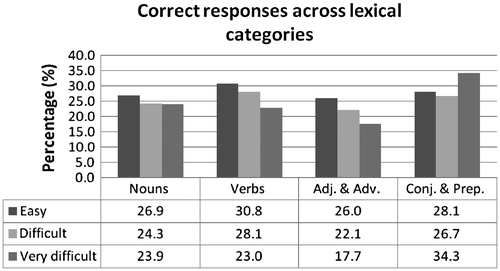
Figure summarizes and depicts percentages of errors in each lexical category arranged by difficulty level. As demonstrated, nouns were read with less serious errors than adjectives and adverbs. This result was expected because the ability to read nouns is established at this age (Morris, Citation2008).
The interesting results were that the percentages of reading errors across all the difficulty levels in the verb lexical category were less than those in the nouns lexical category. Such as finding was unexpected because reading skills develop simulating oral language acquisition, i.e. the child would acquire the ability to read nouns earlier than verbs (Morris, Citation2008; Plante & Beeson, Citation2013). It is well documented that in English oral language acquisition, the linguistically developing child acquires 50 single words (mostly nouns) and uses them in two-word sentences at the age of 18 months, acquires 900 words by the age of 3 years, and dramatically increases his/her word count to reach 1,500 words by the age of 4 years (Plante & Beeson, Citation2013). Additionally, the bulk of oral language acquisition research data in normally developing children report that young children acquire nouns prior to verbs, adjectives, adverbs, conjunctions, and prepositions. Children usually can use most verbs, adjectives, adverbs, conjunctions, and prepositions orally at the age of 5 (Owens, Metz, & Hass, Citation2011).
In contrast, reading skills begin at a later stage (at age 6 or 7 years) where the learner becomes aware of the relationship between sounds and letters (sound–symbol correspondence) and begins applying the knowledge to text (Morris, Citation2008), for which phonological awareness is a pre-requisite. In fact, literacy research has well established that phonological awareness and phoneme–grapheme conversion is fundamental for acquiring reading and the failure to acquire such a skill will result in difficulties in children learning to read (Wagner & Torgesen, Citation1987). Additionally, studies indicate that phonological awareness was the best predictor of learning to read (Anthony et al., Citation2007). That is, phonological awareness, as well print awareness, and oral language, are considered three important areas associated with emergent reading abilities. As such, activating the phonological awareness is critical in the process of learning to read (Ehri, Citation1992).
A possible ascription for this result is that teachers may assume that the pattern of acquiring the skills of decoding nouns would follow the same sequence of oral language acquisition (i.e. preschool children acquire nouns before verbs) (Catts et al., Citation2001; Hegde & Maul, Citation2006). Therefore, the lesser number of errors in reading verbs than nouns may be attributed to the individual instructional styles, where teachers may emphasize the acquisition of reading verbs more than nouns in their teaching strategies. Thus, nouns may not be given due importance due to the possible teachers’ misconceptions that nouns are acquired at an earlier age from an oral language perspective. That is, there may be a misconception that if children can use more nouns than verbs in their conversations, then nouns should be easier to read, and the instruction should focus more on reading verbs. However, the acquisition of reading follows a somewhat different, more complex acquisition process. For example, the first stage of reading development appears to begin well after oral language acquisition (at age 6 or 7 years) and needs formal instruction, i.e. teaching.
The study conducted by Sartawi, Natour, and Smadi (Citationin press) posits that the types of approaches and methods used in teaching affects the learning process. For example, the modified reciprocal teaching was found to be more effective for teaching language and communications skills that the conventional method. One of the shortcomings of this study its lack of investigation of the current methods used in teaching of reading and language skills, or the focus of such teaching strategies in terms of lexical categories on the acquisition of language skills. Curricula need to be developed according to rationalized evidence that shows the order of lexical categories that needs to be followed in teaching students’ reading skills. In addition, the effective approaches and strategies used to teach students reading skills need to be developed and updated based on evidence from research.
The literature shows that programs or interventions directed to promote reading should be based on, first, researching the source of limitation as it can be related to auditory–sensory temporal processing issues, or to cognitive issues (working memory or attention), or transferring cognitive or auditory skills (Murphy, Moore, & Schochat, Citation2015; Pires, Mota, & Pinheiro, Citation2015). Second, there has been a lack of consistency of the methodological factors used in researching the effectiveness of the various approaches directed to enhance reading and speech skills. In return, this created a controversy as to which the most suitable approach to use and in which type of condition (Murphy et al., Citation2015; Pires et al., Citation2015).
Although following the same general trend of more frequency of reading errors across the difficulty levels, adjectives and adverbs had the highest percentages of errors in the easy and the difficult levels, whereas the nouns had the highest percentage of errors in the very difficult level. This could be due to their dynamic nature (i.e. require other senses and or varying dimension of time and place), where adjectives describe nouns and adverbs describe time or place. The percentage of errors in the very difficult level of the noun category is the only level that exceeded its correspondent level of the adjective category. This can be attributed to the infrequent use of the words in colloquial dialect listed in the very difficult level of the noun category compared to the same level of difficulty listed in the adjective category.
The least errors in reading prepositions and conjunctions are probably due to their lesser number (10% of words) and their structural simplicity (less connected letters, less syllables etc.) and simpler morphology. As such, looking into the patterns of errors in the four lexical categories was necessary to shed light on the nature of reading errors prevailing in the current research.
5.4. Gender against reading error patterns, the lexical categories, and levels of difficulty
Figure shows that female students committed less reading errors across all lexical categories compared to the males students. This result is expected as the literature shows that reading and language acquisition skills are higher in females compared to the case of males (Vogel, Citation1990).
Figure compares between males and females against each reading error pattern while Table demonstrates whether the differences between males and females across the reading error patterns are significant or not using Mann–Whitney U test. As depicted in Figure , males scored higher percentages in all of the reading error patterns except in error 5, the non-discrimination between the /h/ (al-ha’) and the /t/ (at-ta’ al-marbouta) at the end of words.
Table 2. Mann–Whitney U test (type of error across gender)
Table demonstrates the results of the Mann–Whitney U test when comparing between males and females across the nine types of reading error patterns. As shown, there were significant difference between males and females in reading error patterns type 1, 2, 3, 7, and 8, and which was in favor of female students. That means that females significantly committed less reading errors in the following error patterns: inability to read the word (error 1), omission of a letter or a syllable (error 2), substitution of a letter or a syllable (error 3), not reading the glottal stop /ʡ/ (hamza) (error 7), and reading the geminated letter as ingeminated (error 8). However, in error reading patterns type (4, 5, and 6) there was no significant difference between males and females in terms of the frequency of committing of those error patterns. As explained in the previous sections, it was expected that females would perform better than males in reading as indicated by committing less errors as supported by the literature. Quinn and Wagner (Citation2013) found that the reading errors are more frequent in males than the females.
The fact that the participating students, males and females, were able to read the majority of presented words (77.8%) correctly is typical because the first-grade Arabic curriculum is designed in a way to accommodate the level of reading acquisition of the first grade (ADEC Policy Manual, Citation2013). Thus, it seems that the error patterns prevalent in this investigation were likely representing the typical errors committed by first graders learning to read Arabic. This was evident by the prevalence of error 1, the inability to read the word, which was generally the most frequent reading error pattern across all categories as shown in Figure and Table . This could be the case as this error pattern was prevalent in the prepositions and conjunctions category, and was the most frequent in the easy level of this lexical category.
The typicality of the error patterns committed by first graders is also evidenced by the consistent pattern of reading errors in each lexical category across levels of difficulty (see Figure ). In other words, error patterns simply reflect an emerging experience with reading, knowing that the data was collected after one semester of formal reading instruction.
The results presented in this investigation form preliminary guidelines for adjusting instructional strategies. For example, it is not always accurate to focus on reading nouns as an easier task to start with than reading verbs. Starting with nouns is based on the assumption that reading skills develop simulating oral language acquisition, i.e. the child would acquire the ability to read nouns earlier than verbs. However, it seems that reading instruction should equally focus on reading nouns and verbs, and maybe more focus on reading verbs more than nouns.
Instructional strategies for teaching first graders how to read should also take into consideration that learners at this stage need to become aware of the relationship between sounds and letters (sound–symbol correspondence) and begin applying the knowledge to text (Sartawi, Citation1999). That is, phonological awareness as well print awareness and oral language, are considered three important areas associated with emergent reading abilities (Morris, Citation2008). Thus, it seems that the acquisition of reading may follow a different acquisition process, where it begins after the oral language acquisition (at age 6 or 7 years) and needs formal instruction.
6. Conclusion
The fact that the participating students were able to read the majority of presented words correctly is expected because the first-grade Arabic curriculum is designed in a way to accommodate the level of reading acquisition of the first grade (ADEC Policy Manual, Citation2013). Thus, it seems that the error patterns prevalent in this investigation are likely representing the typical errors committed by first graders learning to read Arabic. This entails better understanding of the reading difficulties in Emirati Arab developing readers. Those difficulties may stem from a distinct, though interrelated, threefold paradigm: difficulty level of the read words (i.e. morphological complexity), lexical category (nouns, verbs, adjective and adverbs, prepositions and conjunctions), and nature of error patterns. Being able to detect this threefold paradigm in individual students may be helpful in predicting reading early on and designing the appropriate remedial plans.
Further research will target second grade students who should be at a more advanced reading level.
7. Further research
Though this study offered a systematic approach in establishing criteria for evaluating the difficulty of the words, and judging the severity of reading error patterns, it had limitations. The focus and the strategies of the instructional media and their effects on reading acquisition were not researched in this study, yet speculations were made concerning the presence of a connection between the instructional media and the acquisition of reading skills. Further research is needed to target the focus of the current teaching strategies used to facilitate reading acquisition, and to explore the basis that grounds the employment of such strategies.
Furthermore, research is needed to support whether the acquisition of Arabic reading occurs in the same sequence as to that of oral language acquisition (i.e. nouns before verbs). This would assist in determining whether teaching needs to focus on the acquisition of lexical categories in order and according to a specific sequence throughout the process of reading acquisition.
Correction
This article was originally published with errors. This version has been corrected as follows: Arabic transcripts have been amended.
Additional information
Funding
Notes on contributors
Yaser S. Natour
The authors formulated their research team to participate in renovating the methods used for teaching in the Middle East region.
Yaser S. Natour is an associate professor with 20 years of experience in speech–language pathology, and currently working as an associate professor at the University of Jordan.
Wesam Darawsheh
Wesam B. Darawsheh is an assistant professor at the University of Jordan. She is qualified occupational therapist with a particular interest in contemporary issues such as cultures and their effect on education, and development.
AbdelAziz M. Sartawi
AbdelAziz M. Sartawi is a professor at the Department of Special Education at the United Arab Emirates University, and has a 25 years of experience in his field.
Basem A. Marie
Basem A. Marie is an assistant professor at the Audiology and Speech–Language Pathology Department at Al-Ahliyya Amman University.
Effie Efthymiou
Effie Efthymiou has an experience of about 15 years in special education and has been working as an assistant professor at the United Arab Emirates University.
References
- Abu Dhabi Council for Education Policy Manual. (2013). 2012-2013: P-12 Policy Manual. Retrieved from http://www.adec.ac.ae/en/MediaCenter/Publications/ADEC_PolicyManual_EN_2012-13/index.html
- Adams, M. J. (1990). Beginning to read: Thinking and learning about print. Cambridge, MA: MIT Press.
- Anthony, J. L., Williams, J. M., McDonald, R., & Francis, D. J. (2007). Phonological processing and emergent literacy in younger and older preschool children. Annals of Dyslexia, 57, 113–137.10.1007/s11881-007-0008-8
- Baumann, J. F., Edwards, E. C., Font, G., Tereshinski, C. A., Kame’enui, E. J., & Olejnik, S. F. (2002). Teaching morphemic and contextual analysis to fifth-grade students. Reading Research Quarterly, 37, 150–176.10.1598/RRQ.37.2.3
- Biemiller, A., & Boote, C. (2006). An effective method for building meaning vocabulary in primary grades. Journal of Educational Psychology, 98, 44–62.10.1037/0022-0663.98.1.44
- Bowers, P., & Kirby, J. (2010). Effects of morphological instruction on vocabulary acquisition. Reading and Writing, 23, 515–537.10.1007/s11145-009-9172-z
- Bowers, P. N., Kirby, J. R., & Deacon, S. H. (2010). The effects of morphological instruction on literacy skills: A systematic review of the literature. Review of Educational Research, 80, 144–179.10.3102/0034654309359353
- Bus, A. G., van IJzendoorn, M. H., & Marinos, H. (1999). Phonological awareness and early reading: A meta-analysis of experimental training studies. Journal of Educational Psychology, 91, 403–414.10.1037/0022-0663.91.3.403
- Carlisle, J. F. (1995). Morphological awareness and early reading achievement. In L. B. Feldman (Ed.), Morphological aspects of language processing (pp. 189–210). Hillsdale, NJ: Lawrence Erlbaum.
- Carlisle, J. F. (2003). Morphology matters in learning to read: A commentary. Reading Psychology, 24, 291–322.10.1080/02702710390227369
- Carlisle, J. F., & Katz, L. (2006). Effects of word and morpheme familiarity on reading of derived words. Reading and Writing, 19, 669–693.10.1007/s11145-005-5766-2
- Carlisle, J. F., & Stone, C. A. (2005). Exploring the role of morphemes in word reading. Reading Research Quarterly, 40, 428–449.10.1598/RRQ.40.4.3
- Catts, H. W. (1993). The relationship between speech-language impairments and reading disabilities. Journal of Speech Language and Hearing Research, 36, 948–958.10.1044/jshr.3605.948
- Catts, H. W., Fey, M. E., Zhang, X., & Tomblin, B. J. (2001). Estimating the risk of future reading difficulties in kindergarten children: A research based model and its clinical implementation. Language, Speech, and Hearing Services in Schools, 32, 38–50.10.1044/0161-1461(2001/004)
- Crosbie, S., Pine, C., Holm, A., & Dodd, B. (2006). Treating Jarrod: A core vocabulary approach. Advances in Speech–Language. Pathology, 8, 316–321.
- Deacon, S. H., & Kirby, J. R. (2004). Morphological awareness: Just “more phonological”? The roles of morphological and phonological awareness in reading development. Applied Psycholinguistics, 25, 223–238.
- Deacon, S. H., Parrila, R., & Kirby, J. R. (2008). A review of the evidence on morphological processing in dyslexics and poor readers: A strength or weakness? In F. Manis, A. Fawcett, G. Reid, & L. Siegel (Eds.), The SAGE Handbook of Dyslexia (pp. 212–238). London: Sage.10.4135/9780857020987
- Ehri, L. C. (1992). Reconceptualizing the development of sight word reading and its relationship to recoding. In P. Gough, L. C. Ehri, & R. Treiman (Eds.), Reading Acquisition (pp. 107–143). Hillsdale, NJ: Laurence Erlbaum Associates.
- Elbro, C., & Arnbak, E. (1996). The role of morpheme recognition and morphological awareness in dyslexia. Annals of Dyslexia, 46, 209–240.10.1007/BF02648177
- Fareh, Sh, Hamdan, J., Amayreh, M., & Anani, M. (2000). Introduction to Linguistics. Amman: Wail Publication.
- Felton, R. H., & Brown, I. S. (1990). Phonological processes as predictors of specific reading skills in children at risk for reading failure. Reading and Writing: An Interdisciplinary Journal, 2, 39–59.10.1007/BF00383373
- Fowler, A. E., & Liberman, I. Y. (1995). The role of phonology and orthography in morphological awareness. In L. B. Feldman (Ed.), Morphological aspects of language processing (pp. 157–188). Hillsdale, NJ: Lawrence Erlbaum.
- Ghaemi, H. (2009). The effect of morphological training on word reading and spelling of Iranian dyslexic children. World Applied Sciences Journal, 7, 57–66.
- Goodwin, A., & Ahn, S. (2010). A meta-analysis of morphological interventions: effects on literacy achievement of children with literacy difficulties. Annals of Dyslexia, 60, 183–208.10.1007/s11881-010-0041-x
- Griffiths, P. (1991). Word-finding ability and design fluency in developmental dyslexia. British Journal of Clinical Psychology, 30, 47–60.10.1111/bjc.1991.30.issue-1
- Hegde, M. N., & Maul, C. A. (2006). Language Disorders in Children: An Evidence-Based Approach to Assessment and Treatment. Boston, MA: Allyn & Bacon, Inc.
- Henry, M. K. (1989). Children’s word structure knowledge: Implications for decoding and spelling instruction. Reading and Writing: An Interdisciplinary Journal, 1, 135–152.10.1007/BF00377467
- Henry, M. K. (2003). Unlocking literacy: Effective decoding and spelling instruction. Baltimore, MD: Brooks publishing.
- Hoskyn, M., & Swanson, L. (2000). Cognitive processing of low achievers and children with reading disabilities: A selective meta-analytic review of the published literature. School Psychology Review, 29, 102–119.
- Law, J., Wouters, J., & Ghesquière, P. (2015). Morphological awareness and its role in compensation in adults with Dyslexia. Dyslexia, 21, 254–272.10.1002/dys.v21.3
- Leong, C. K. (1989). The effects of morphological structure on reading proficiency. A developmental study. Reading and Writing: An Interdisciplinary Journal, 1, 357–379.10.1007/BF00386267
- Mahfoudhi, A., Elbeheri, G., Al-Rashidi, M., & Everatt, J. (2010). The role of morphological awareness in reading comprehension among typical and learning disabled native arabic speakers. Journal of Learning Disabilities, 43, 500–514.10.1177/0022219409355478
- McLeod, A., & Apel, K. (2015). Morphological awareness intervention: Study of a child with a history of speech and language impairment. Communication Disorders Quarterly, 36, 208–218.10.1177/1525740114560371
- Morris, D. (2008). Diagnosis and Correction of Reading Problems. NY: Guilford Publications Inc.
- Morton, R. (2011). Phonological awareness and reading ability in children. Southern Illinois University Carbondale research papers. Paper 94. Retrieved from http://opensiuc.lib.siu.edu/gs_rp/94
- Murphy, C., Moore, D., & Schochat, E. (2015). Generalization of auditory sensory and cognitive learning in typically developing children. PLOS one. doi:10.1371/journal.pone.0135422
- Murphy, C., Pagan-Neves, L., Wertzner, H., & Schochat, E. (2015). Children with speech sound disorder: comparing a non-linguistic auditory approach with a phonological intervention approach to improve phonological skills. Frontiers in Psychology, 6. doi:10.3389/fpsyg.2015.00064
- Nagy, W. E. (2005). Why vocabulary instruction needs to be long term and comprehensive. In E. H. Hiebert & M. L. Kamil (Eds.), Teaching and learning vocabulary: Bringing research to practice (pp. 27–44). Mahwah, NJ: Lawrence Erlbaum Associates.
- National Early Literacy Panel. (2007). Findings from the national early literacy panel: Providing a focus for early language and literacy development, presented at The National Center on Family Literacy 16th Annual Conference, Orlando, 2007. Florida, FL.: The National Center for Family Literacy.
- National Reading Panel. (2000). Teaching children to read: An evidence- based assessment of the scientific research literature on reading and its implications for reading instruction. Washington, DC: National Institute of Child Health and Human Development.
- Owens, R., Metz, D., & Hass, A. (2011). Introduction to Communication Disorders: A lifespan perspective (3rd ed.). Boston, MA: Pearson Education Inc.
- Pires, M., Mota, M., & Pinheiro, M. (2015). The memory systems of children with (central) auditory disorder. CoDAS, 27, 326–332.10.1590/2317-1782/20152015018
- Plante, E., & Beeson, P. (2013). Communication and Communication Disorders (4th ed.). Boston, MA: Pearson Education Inc.
- Pokorni, J. L., Worthington, C. K., & Jamison, P. J. (2004). Phonological awareness intervention: Comparison of Fast ForWord, Earobics, and LiPS. The Journal of Educational Research, 97, 147–158.10.3200/JOER.97.3.147-158
- Pratt, A. C., & Brady, S. (1988). Relation of phonological awareness to reading disability in children and adults. Journal of Educational Psychology, 80, 319–323.10.1037/0022-0663.80.3.319
- Quinn, J., & Wagner, R. (2013). Gender differences in reading impairment and in the identification of impaired readers: results from a large-scale study of at-risk readers. Journal of Learning Disability, 48, 433–445.
- Rapala, M. M., & Brady, S. (1990). Reading ability and short-term memory: The role of phonological processing. Reading and Writing: An Interdisciplinary Journal, 2, 1–25.10.1007/BF00383371
- Rohl, M., & Pratt, C. (1995). Phonological awareness, verbal working memory and the acquisition of literacy. Reading and Writing: An Interdisciplinary Journal, 7, 327–360.10.1007/BF01027723
- Roman, A. A., Kirby, J. R., Parrila, R. K., Wade-Woolley, L., & Deacon, S. H. (2009). Toward a comprehensive view of the skills involved in word reading in Grades 4, 6, and 8. Journal of Experimental Child Psychology, 102, 96–113.10.1016/j.jecp.2008.01.004
- Sartawi, A. (1999). Effectiveness of methods for improving reading comprehension skills of students with learning disabilities. Journal of King Saud University, 11, 165–175.
- Sartawi, A., Natour, Y., & Smadi, J. (in press). Efficacy of reading strategies for female school age children: typical children versus children with mental handicap. University of Sharjah Journal for Humanities and Social Sciences.
- Schuele, M. C., & Boudreau, D. (2008). Phonological awareness intervention: Beyond the Basics. Language Speech and Hearing Services in Schools, 39, 3–20.10.1044/0161-1461(2008/002)
- Scott, J. A. (2005). Creating opportunities to acquire new word meaning from text. In A. Hiebert & M. Kamil (Eds.), Teaching and learning vocabulary: Bringing research to practice (pp. 69–94). Mahwah, NJ: Lawrence Erlbaum Associates.
- Sforza, C., Soudi, A., & Teruko, M. (2000). Arabic morphology generation using a concatenative strategy. Presented at The First Conference of the North-American Chapter of the Association for Computational Linguistics, Seattle, 2000. Washington.: Association for Computational Linguistics.
- Siegel, L. S. (2008). Morphological awareness skills of english language learners and children with Dyslexia. Topics in Language Disorders, 28, 15–27.10.1097/01.adt.0000311413.75804.60
- Singson, M., Mahony, D., & Mann, V. (2000). The relation between reading ability and morphological skills: Evidence from derivational suffixes. Reading and Writing: An Interdisciplinary Journal, 12, 219–252.10.1023/A:1008196330239
- Snowling, M., Goulandris, N., Bowlby, M., & Howell, P. (1986). Segmentation and speech perception in relation to reading skill: A developmental analysis. Journal of Experimental Child Psychology, 41, 489–507.10.1016/0022-0965(86)90006-8
- Stanovich, K. E. (1988). Explaining the differences between the Dyslexic and the garden-variety poor reader: The phonological-core variable-difference model. Journal of Learning Disabilities, 21, 590–604.10.1177/002221948802101003
- Stanovich, K. E., & Siegel, L. S. (1994). Phenotypic performance profile of children with reading disabilities: A regression-based test of the phonological-core variable-difference model. Journal of Educational Psychology, 86, 24–53.10.1037/0022-0663.86.1.24
- Stone, B., & Brady, S. (1995). Evidence for deficits in basic phonological processes in less-skilled readers. Annals of Dyslexia, 45, 51–78.10.1007/BF02648212
- Swank, L. K., & Catts, H. W. (1994). Phonological awareness and written word decoding. American Speech-Language-Hearing Association, 25, 9–14.
- Templeton, S. (1989). Tacit and explicit knowledge of derivational morphology: Foundations for a unified approach to spelling and vocabulary development in the intermediate grades and beyond. Reading Psychology, 10, 233–253.10.1080/0270271890100303
- Templeton, S. (2004). The vocabulary-spelling connection: Orthographic development and morphological knowledge at the intermediate grades and beyond. In J. F. Baumann & E. J. Kame’enui (Eds.), Vocabulary instruction: Research to practice (pp. 118–138). New York, NY: Guilford Press.
- Torgesen, J. K., Wagner, R. K., Rashotte, C. A., Herron, J., & Lindamood, P. (2010). Computer-assisted instruction to prevent early reading difficulties in students at risk for dyslexia: Outcomes from two instructional approaches. Annals of Dyslexia, 60, 40–56.10.1007/s11881-009-0032-y
- Torgesen, J. K., Wagner, R. K., Rashotte, C. A., Rose, E., Lindamood, P. L., & Conway, T. (1999). Preventing reading failure in young children with phonological processing disabilities: Group and individual responses to instruction. Journal of Educational Psychology, 91, 579–593.10.1037/0022-0663.91.4.579
- Van Riper, C. (1939). Speech correction: Principles and methods. Englewood Cliffs, NJ: Prentice-Hall.
- Verhoeven, L., & Perfetti, C. (2011). Morphological processing in reading acquisition: A cross-linguistic perspective. Applied Psycholinguistics, 32, 457–466.10.1017/S0142716411000154
- Vogel, S. (1990). Gender differences in intelligence, language, visual-motor abilities, and academic achievement in students with learning disabilities: A review of the literature. Journal of Learning Disabilities, 23, 44–52.10.1177/002221949002300111
- Wagner, R. K., & Torgesen, J. K. (1987). The nature of phonological processing and its causal role in the acquisition of reading skills. Psychological Bulletin, 101, 192–212.10.1037/0033-2909.101.2.192
- Wagner, R. K., Torgesen, J. K., Rashotte, C. A., Hecht, S. A., Barker, T. A., & Burgess, S. R. (1997). Changing relations between phonological processing abilities and word-level reading as children develop from beginning to skilled readers: A 5-year longitudinal study. Developmental Psychology, 33, 468–479.10.1037/0012-1649.33.3.468
- Watson, J. (2002). The phonology and morphology of Arabic. New York, NY: Oxford University Press.
- Wise, B. W., Ring, J., & Olson, R. K. (1999). Training phonological awareness with and without explicit attention to articulation. Journal of Experimental Child Psychology, 72, 271–304.10.1006/jecp.1999.2490
- Wolf, M., & Obregón, M. (1992). Early naming deficits, developmental dyslexia, and a specific deficit hypothesis. Brain and Language, 42, 219–247.10.1016/0093-934X(92)90099-Z

